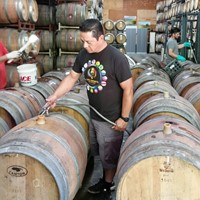American Oak
-
Staving Time
February 1, 2021 14:36

Just like vineyards there are seasons in the cellar too. Barrels are the focus of wintertime. Harvest begins the cycle each year and a couple of months later the process begins. Barrels are emptied of the previous vintage and makes room for the new one, typically called barreling down. Let’s take a look at what aging does to wine.
Why do we barrel age wine at all? Think about it in this way. If you have a raw piece of wood that needs the edge taken off and you’d like to use it as a frame, you’d start sanding and shaping it. The same thing happens in barrel-the wine is raw and rough when it is transferred. Aging for an average of one year helps to smooth out those rough edges and provides the framing of flavor and body.
This is a part of a wine’s journey where it seems like there isn’t anything going on but you and I know there is. Oxygenation is the process and takes time to slowly change the wine from its’ youthful and raw exuberance to a more refined and drinkable one. The barrel itself isn’t airtight and allows a very small amount of oxygen in to soften the wine. And it exhales too-sometimes referred to as the ‘angel’s share’ and why the cellar and barrel room smell so wonderful, the bouquet of wine in its’ many states. Another benefit is concentration. With evaporation of water and even alcohol you get concentrated flavors, enhancing the fruit profile of the wine.
Each barrel is taken down three times during the course of aging to replace the wine lost to oxygenation thereby preventing any possible spoilage-this is called topping the barrels. The photo I included above features this process and our Cellarmaster Polo Cano knows each barrel and wine like the back of his hand. The time spent in oak not only slowly ages the wine it also steeps in the oak, which imparts the element of toast, vanilla and nut aromas often detected in the bouquet of barrel aged wines. This adds another level of complexity and plays an important role in quality, aroma and taste of the finished wine. Our winemaking style calls for 25 to 30% new oak blended with seasoned barrels. This helps us keep a balance between the fruit and the oak components for a ‘just right’ taste in your glass. The give and take during the aging process from the first moment in barrel to the last as the wine is prepared for bottling provides a canvas for the variety. Some of our wines are aged less than a year (Pinot Noir and Sonoma Classico) and others like our Wisdom Cabernet Sauvignon spend nearly two years. It is determining what is best for the grape that makes these wines so well crafted.
Categories
- COVID
- Follow the Vineyard
- Note from Home
- PairItWithPed
- Pandemic
- pedroncelli
- Port
- Postcards from Home
- Pruning
- Seasons in The Cellar
- Tasting Room
- Thanksgiving
- Vintage Notes
- Winemaking
- Women's History Month
Recent posts
-
91 Years Later
-
Come Over October: It's About Community
-
Come Over October
-
A Legacy Continues!
-
Everything Old is New Again
Popular tags
- Harvest 2022
- Pantry
- Courage Zinfandel
- Oak
- cooking with wine
- OpenThatBottleNight
- family
- Holding steady
- Merlot
- Crop set
- Follow the Vineyard
- Sauvignon Blanc
- Cellar Master
- Library Wine
- COVID Coffee Chat
- Rosé
- Down to Earth
- Pandemic
- Bushnell Vineyard
- American Oak
- Cabernet Sauvignon
- Easter
- PairitwithPed
- note from home
- Anniversary
- Estate Vineyard
- Sonoma County
- newsletter
- Pruning
- Reserve
- Cookies
- Heat wave
- Habit
- Seasons in The Cellar
- Schotzki
- COVID19
- 1974 Cabernet Sauvignon
- cheese
- Dry Creek Valley
- Four Grapes Port
- Barrels
- Homecooking
- Lake Sonoma
- Recipes
- Block 007 Cabernet Sauvignon
- Mother Clone
- food and wine
- Pedroncelli
- French Oak
- Finding Your Roots





